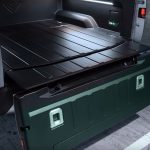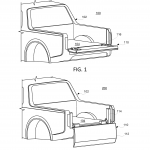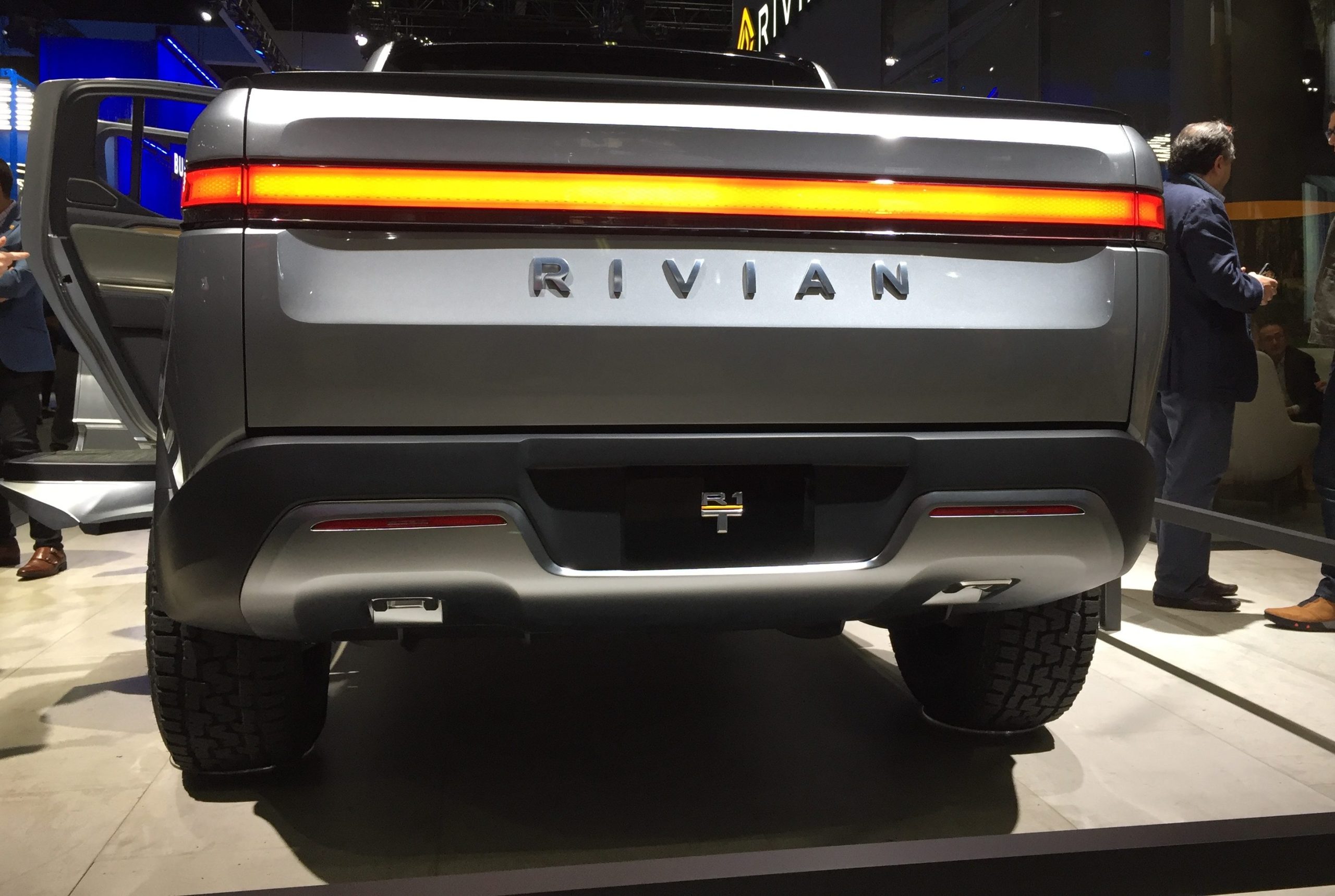
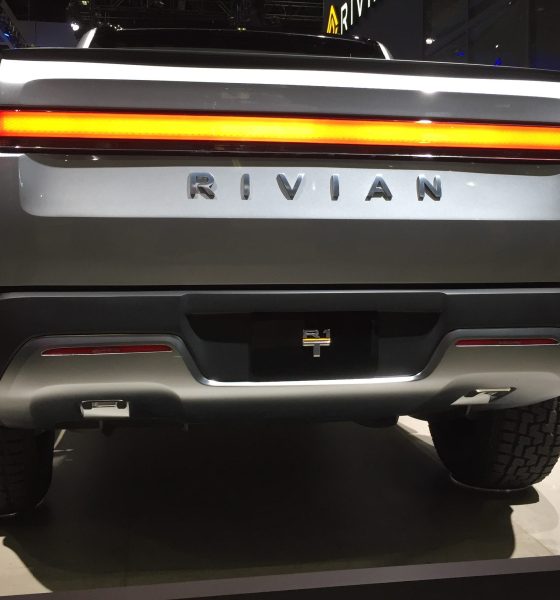
News
Rivian R1T’s new tailgate patent makes for effortless loading and unloading
Electric car startup Rivian has submitted a patent for a “Swing and Drop Tailgate” door that would allow for easier access to the bed of the R1T pickup truck.
Rivian’s patent was inspired by a traditional truck’s tailgate door, which tends to restrict access to the bed of a pickup. The new design for the tailgate door utilizes multiple hinges, allowing several different trajectories of movement and multiple resting positions. The idea behind this patent is to improve upon the traditional truck bed door design, a concept Rivian feels has drawbacks.
“One drawback to this motion is that the tailgate now protrudes rearward of the vehicle, blocking the user from standing closer to the vehicle,” the patent states.
Other truck manufacturers have seen this traditional door as a drawback and have utilized a door that opens from the side with a hinge, a setup that’s pretty much identical to a regular door that’s used in homes or buildings.
However, Rivian argues that this idea also has its issues, citing the need for excessive amounts of space to open the side-hinged door. “Other motions of a tailgate, such as a side-hinged tailgate that opens to the side may allow a user to stand closer to the vehicle, but this motion requires significant clearance and does not allow the increased horizontal space that the dropped down tailgate provides. It would be desirable for a tailgate to be capable of more than one motion, along more than one trajectory, to more conveniently adapt to a user’s needs,” the patent’s description added.
Illustrations of the new tailgate patent from Rivian show the door having the ability to open much like a traditional tailgate, but also the ability to swing down behind the rear of the vehicle. This would give a person trying to gain access to the bed the ability to get closer to the truck, allowing for easier loading and unloading of items on the R1T’s primary cargo area.
- Credit: YouTube/Auto INTERIOR
- Rivian’s illustration for a “Swing and Drop Tailgate” design. (Credit: Rivian)
Rivian’s “Swing and Drop Tailgate” design ultimately allows the R1T’s tailgate to move in multiple different ranges of motion. This design brings several advantages, with its different movements and trajectories allowing users to not worry about the space available around them. Rivian discusses these advantages further in its patent.
“A swing and drop tailgate assembly is configured to undergo more than one motion to provide access to cargo space, for example. For example, a tailgate assembly may be arranged at a boundary of the cargo space (e.g., the rear of a vehicle bed), and is configured to undergo more than one motion to allow access to the cargo space,” the patent description says.
The initial production dates of the Rivian R1T pickup are scheduled for late 2020 or early 2021 according to RJ Scaringe, the company’s CEO. The truck has been available for viewing at a number of Rivian’s reservation holder events and will also be on location at the Fully Charged event in Texas in February 2020. The electric pickup sports an impressive 750 horsepower, three feet of wading depth, 0-60 MPH in three seconds, and a 400+ mile range on its highest-tier variant.

News
Tesla’s new Holiday perk is timed perfectly to make FSD a household name
Tesla AI4 owners get FSD (Supervised) through Christmas, New Year’s Eve and well into the post-holiday travel season.

Tesla quietly rolled out a free Full Self-Driving (Supervised) trial for roughly 1.5 million HW4 owners in North America who never bought the package, and the timing could very well be genius.
As it turns out, the trial doesn’t end after 30 days. Instead, it expires January 8, 2026, meaning owners get FSD (Supervised) through Christmas, New Year’s Eve and well into the post-holiday travel season. This extended window positions the feature for maximum word-of-mouth exposure.
A clever holiday gift
Tesla watcher Sawyer Merritt first spotted the detail after multiple owners shared screenshots showing the trial expiring on January 8. He confirmed with affected users that none had active FSD subscriptions before the rollout. He also observed that Tesla never called the promotion a “30-day trial,” as the in-car message simply reads “You’re Getting FSD (Supervised) For the Holidays,” which technically runs until after the new year.
The roughly 40-day period covers peak family travel and gatherings, giving owners ample opportunity to showcase the latest FSD V14’s capabilities on highway trips, crowded parking lots and neighborhood drives. With relatives riding along, hands-off highway driving and automatic lane changes could become instant conversation starters.
Rave reviews for FSD V14 highlight demo potential
FSD has been receiving positive reviews from users as of late. Following the release of FSD v14.2.1, numerous owners praised the update for its smoothness and reliability. Tesla owner @LactoseLunatic called it a “huge leap forward from version 14.1.4,” praising extreme smoothness, snappy lane changes and assertive yet safe behavior that allows relaxed monitoring.
Another Tesla owner, @DevinOlsenn, drove 600 km without disengagements, noting his wife now defaults to FSD for daily use due to its refined feel. Sawyer Merritt also tested FSD V14.2.1 in snow on unplowed New Hampshire roads, and the system stayed extra cautious without hesitation. Longtime FSD tester Chuck Cook highlighted improved sign recognition in school zones, showing better dynamic awareness. These reports of fewer interventions and a more “sentient” drive could turn family passengers into advocates, fueling subscriptions come January.
Elon Musk
Elon Musk predicts AI and robotics could make work “optional” within 20 years
Speaking on entrepreneur Nikhil Kamath’s podcast, Musk predicted that machines will soon handle most forms of labor, leaving humans to work only if they choose to.
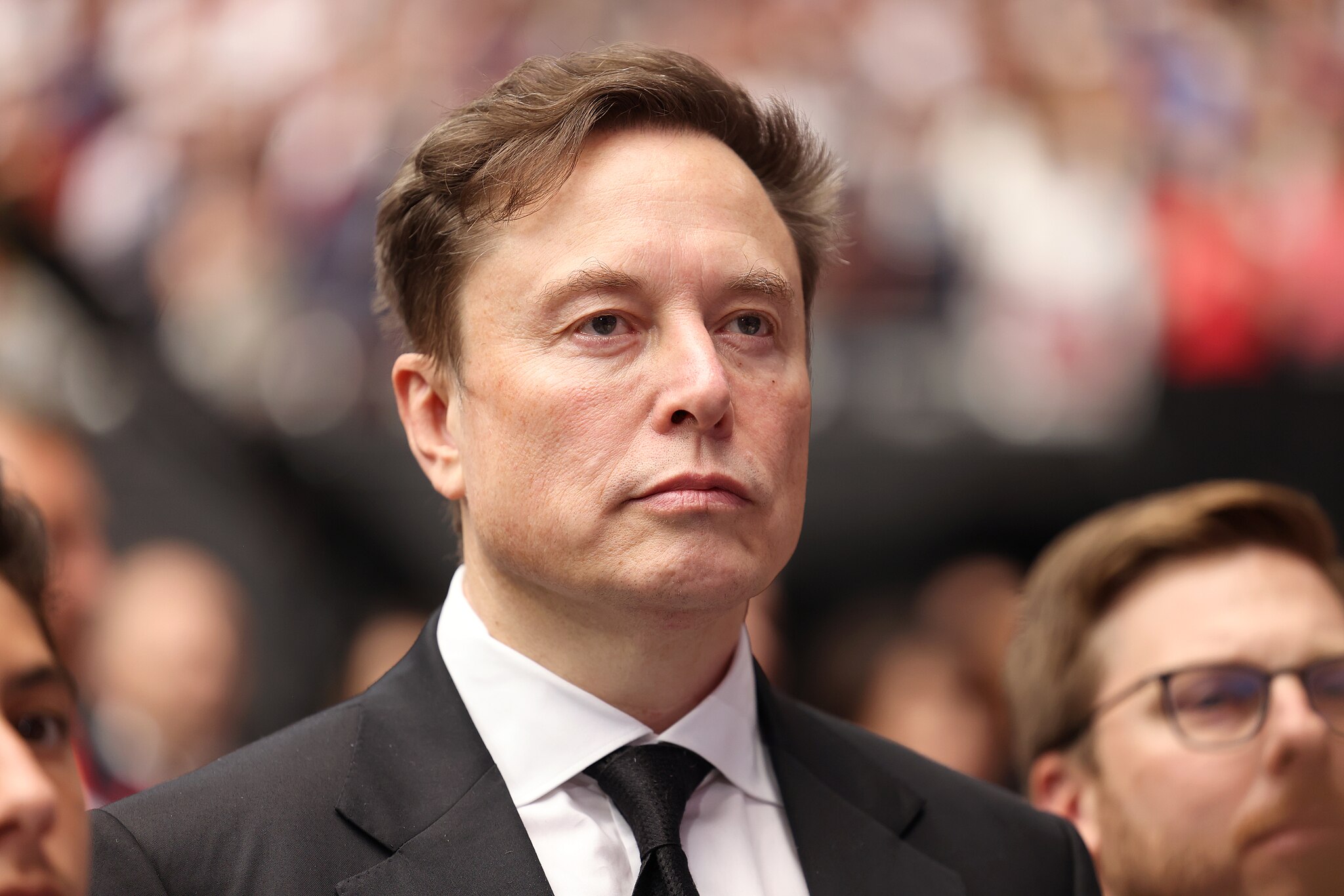
Elon Musk stated that rapid advances in artificial intelligence and robotics could make traditional work unnecessary within two decades.
Speaking on entrepreneur Nikhil Kamath’s podcast, Musk predicted that machines will soon handle most forms of labor, leaving humans to work only if they choose to.
Work as a “hobby”
During the discussion, Musk said the accelerating capability of AI systems and general-purpose robots will eventually cover all essential tasks, making human labor a choice rather than an economic requirement. “In less than 20 years, working will be optional. Working at all will be optional. Like a hobby,” Musk said.
When Kamath asked whether this future is driven by massive productivity growth, Musk agreed, noting that people will still be free to work if they enjoy the routine or the challenge. He compared future employment to home gardening, as it is something people can still do for personal satisfaction even if buying food from a store is far easier.
“Optional” work in the future
Elon Musk acknowledged the boldness of his claim and joked that people might look back in 20 years and say he was wrong. That being said, the CEO noted that such a scenario could even happen sooner than his prediction, at least if one were to consider the pace of the advancements in AI and robotics.
“Obviously people can play this back in 20 years and say, ‘Look, Elon made this ridiculous prediction and it’s not true,’ but I think it will turn out to be true, that in less than 20 years, maybe even as little as ten or 15 years, the advancements in AI and robotics will bring us to the point where working is optional,” Musk said.
Elon Musk’s comments echo his previous sentiments at Tesla’s 2025 Annual Shareholder Meeting, where he noted that Optimus could ultimately eliminate poverty. He also noted that robots like Optimus could eventually provide people worldwide with the best medical care.
Elon Musk
Elon Musk reiterates why Tesla will never make an electric motorcycle
Tesla CEO Elon Musk preemptively shut down speculations about a Tesla road bike once more.
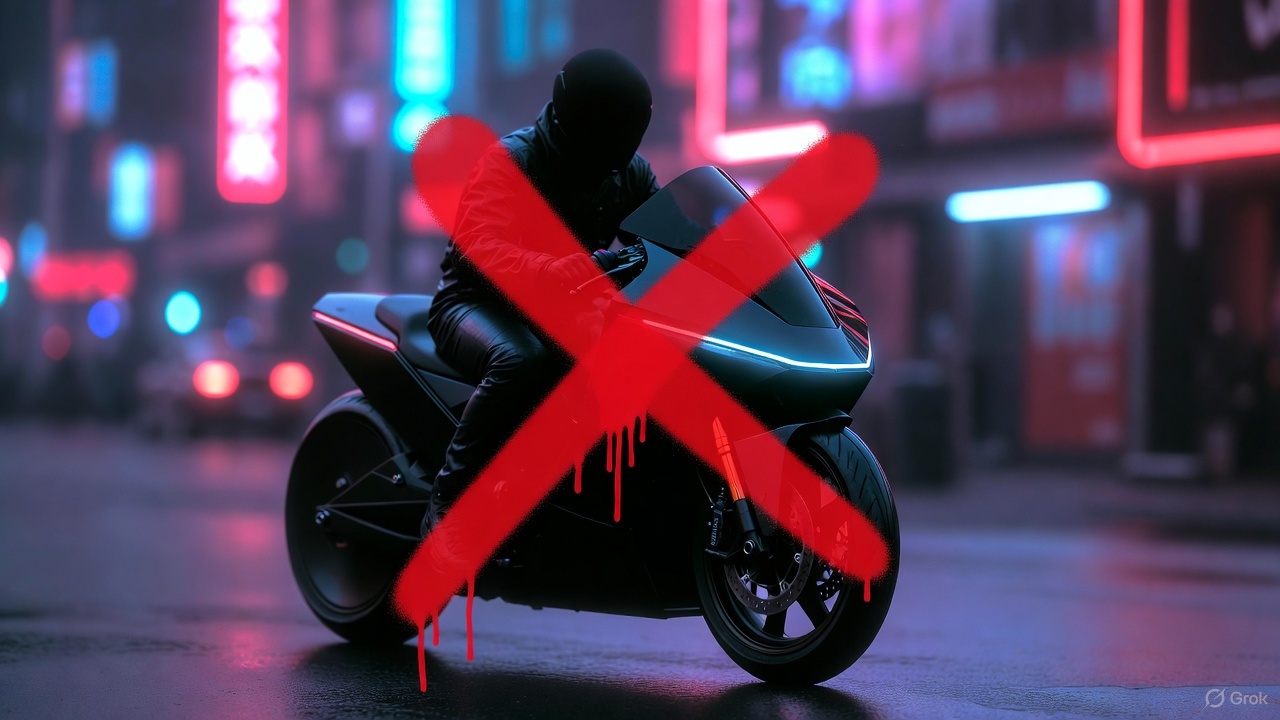
Tesla CEO Elon Musk preemptively shut down speculations about a Tesla road bike once more, highlighting that the electric vehicle maker has no plans to enter the electric motorcycle market.
Musk posted his clarification in a post on X.
Musk’s reply to a fun AI video
X user @Moandbhr posted an AI video featuring the Tesla CEO on the social media platform, captioning it with “Mr. Elon Musk Just Revealed the Game-Changing Tesla Motorcycle.” The short clip depicted Musk approaching a sleek, single-wheeled vehicle, stepping onto it, and gliding off into the distance amid cheers. The fun video received a lot of traction on X, gaining 3.1 million views as of writing.
Musk replied to the post, stating that a Tesla motorcycle is not going to happen. “Never happening, as we can’t make motorcycles safe. For Community Notes, my near death experience was on a road bike. Dirt bikes are safe if you ride carefully, as you can’t be smashed by a truck,” Musk wrote in his reply.
Musk’s Past Comments on Two-Wheelers
Musk also detailed his reservations about motorcycles in a December 2019 X post while responding to questions about Tesla’s potential ATV. At the time, he responded positively to an electric ATV, though he also opposed the idea of a Tesla road-going motorcycle. Musk did state that electric dirt bikes might be cool, since they do not operate in areas where large vehicles like Class 8 trucks are present.
“Electric dirt bikes would be cool too. We won’t do road bikes, as too dangerous. I was hit by a truck & almost died on one when I was 17,” Musk wrote in his post.
Considering Musk’s comments about dirt bikes, however, perhaps Tesla would eventually offer a road bike as a recreational vehicle. Such a two-wheeler would be a good fit for the Cybertruck, as well as future products like the Robovan, which could be converted into an RV.

